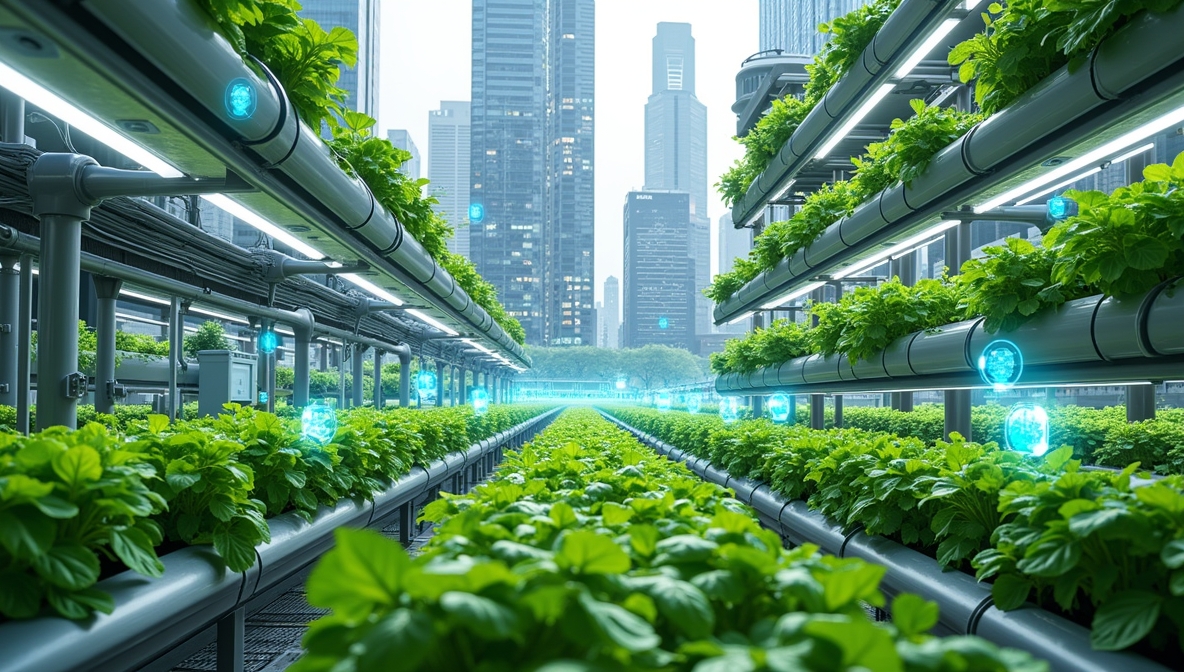INTRODUCTION
Imagine a world where fresh, organic vegetables are grown right in your apartment, all while conserving water by a staggering 90%. This is not a distant dream but a reality made possible by hydroponic urban farming. As cities grow and the demand for sustainable agriculture intensifies, hydroponics—a method that utilizes nutrient-rich water instead of soil—is emerging as a groundbreaking alternative to traditional farming practices. In our fast-paced urban environments, health-conscious city dwellers and families are increasingly looking for reliable, organic, and pesticide-free produce. This article delves into a data-driven analysis of hydroponics versus traditional farming, examining resource efficiency, environmental impacts, economic factors, and future trends.
**Keywords**: hydroponic urban farming, sustainable pesticide-free vegetables, organic indoor farming, AI hydroponic urban farming system
By Richard Peiheng Zhu
Urban farming / Hydroponics Expert / Content creator / Serial Entrepreneur / Member of Mensa Sweden / Member of Swedish Association of Inventors (SUF)

————————————————————
1. RESOURCE EFFICIENCY: Hydroponic Water and Land Usage for Urban Farming
Hydroponic systems stand out for their remarkable efficiency in water usage. Utilizing a closed-loop water recycling process, they can reduce water consumption by up to 90% when compared to conventional farming methods. This innovative approach allows urban farmers to stack multiple growing layers vertically, maximizing yield even in spaces that would otherwise be considered too limited for traditional agriculture.

Copyright:©IWMI / Faseeh Shams
External Link: https://www.fao.org/sustainable-development-goals-data-portal/data/indicators/641-change-in-water-use-efficiency-over-time/en
————————————————————
2. ENVIRONMENTAL IMPACT: Sustainable Hydroponic Systems vs. Traditional Farming
The implementation of controlled-environment agriculture in hydroponics significantly reduces chemical runoff and energy consumption. By producing food locally, hydroponics shortens supply chains and lowers carbon footprints. Research from the USDA and various environmental agencies backs these findings, emphasizing the positive environmental impact of hydroponic systems.
*Explore more at: [USDA Sustainable Agriculture Programs]https://www.nifa.usda.gov/grants/programs/sustainable-agriculture-programs
————————————————————
3. ECONOMIC CONSIDERATIONS: Cost-Effective Hydroponic Indoor Farming
While the initial investment in hydroponic systems may be higher, the long-term savings are notable. Reduced labor, lower water usage, and efficient space utilization lead to significant cost reductions over time. Moreover, urban farmers can charge premium prices for locally grown, pesticide-free produce. A closer look at case studies demonstrates how automated hydroponic setups have successfully increased profit margins.
————————————————————
4. PRODUCT QUALITY: Nutrient-Rich, Pesticide-Free Produce in Hydroponics
One of the most compelling advantages of hydroponics is the precise control over growing conditions, which results in fresher and more nutritious vegetables with extended shelf life. For those interested in starting their own hydroponic journey, step-by-step tutorials on monitoring pH, nutrient levels, and lighting can empower beginners to achieve optimal results.
Example Tutorial: “Build an Automated Hydroponic System”
————————————————————
5. FUTURE TRENDS: Automation, AI, and IoT in Hydroponic Urban Farming
The integration of AI, IoT, and automated systems is transforming urban agriculture. Advances in real-time data analytics and smart sensor technology are making it easier for anyone to manage their own home garden.

————————————————————
CONCLUSION
Hydroponic urban farming represents a powerful solution to the challenges of sustainable, pesticide-free vegetable production in our cities. With significant resource savings, reduced environmental impact, and potential economic benefits, this modern approach aligns perfectly with the needs of health-conscious consumers. Whether you’re just starting out or you’re an experienced urban farmer, adopting these cutting-edge systems can revolutionize your food security and enhance your lifestyle.
————————————————————
FAQ
Q1: What is hydroponic urban farming?
A1: It is a soil-less cultivation method that uses nutrient-rich water to grow plants in controlled environments, ideal for urban settings.
Q2: How much water can hydroponics save compared to traditional farming?
A2: Hydroponic systems can reduce water usage by up to 90%.
Q3: Are hydroponically grown vegetables more nutritious?
A3: Yes, controlled conditions help maximize nutrient retention and minimize pesticide exposure.
Q4: Can beginners successfully manage a hydroponic system?
A4: Absolutely—modern systems come with automated monitoring and user-friendly interfaces.
————————————————————
REFERENCES
– **FAO Water Efficiency Report**: https://www.fao.org/sustainable-development-goals-data-portal/data/indicators/641-change-in-water-use-efficiency-over-time/en
– **USDA Sustainable Agriculture Programs**: https://www.nifa.usda.gov/grants/programs/sustainable-agriculture-programs
– **Nutrient Dynamics in Hydroponics**: https://www.sciencedirect.com/science/article/abs/pii/S0044848697001683
– **Build an Automated Hydroponic System**: https://www.youtube.com/watch?v=nyqykZK2Ev4
– **Wikipedia – Hydroponics**: https://en.wikipedia.org/wiki/Hydroponics